I'd like to introduce the easiest way to grow elderberries ever.
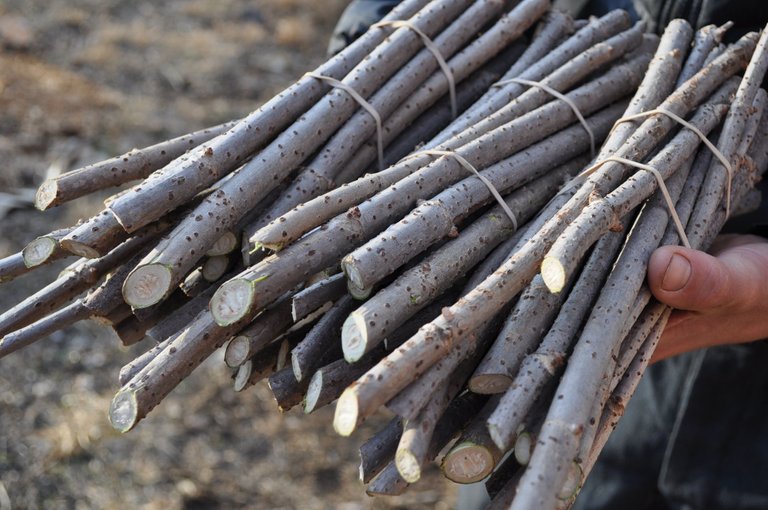
(unless you have a friend who already has the stock and you can get cuttings for free)
If you don't know about elderberries there's a whole world of great information to dive into.
Elderberries and humans have been in partnership for a LONG time. Pan's pipes were fashioned from the stalks and they're used as are slide materials for microscopes, the berries flavored have countless beverages, neutralized a bazillion free radicles in bodies throughout the world over time, cured many ailments, dyed many fabrics, and the flowers have created lovely bouquets in champagnes and fed oodles of honeybees.
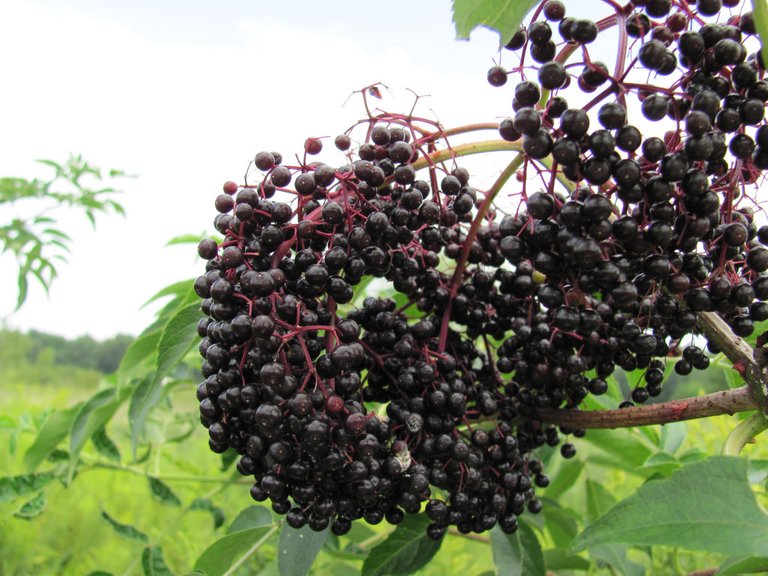
Interested yet?
Oh, did I mention they grow in full sun to partial shade
and will tolerate a wide range of soil conditions?
Keep reading to find out how to propagate this fantastic species easily and economically.
Growing your own medicinal fruit
Elders can be propagated in a variety of ways. What we will highlight is what we believe is the lowest input and most natural method of propagating or cloning elderberries. Once established, elderberries will provide a great boost to your immunity as the berries have strong antiviral properties. Their antioxidant levels on the ORAC scale top out at 14 500, that's almost triple the antioxidants concentrations in blackberries! For a fruit that not only tastes good but also has such potent medicinal qualities and is easy to grow its a wonder more folks aren't growing it.
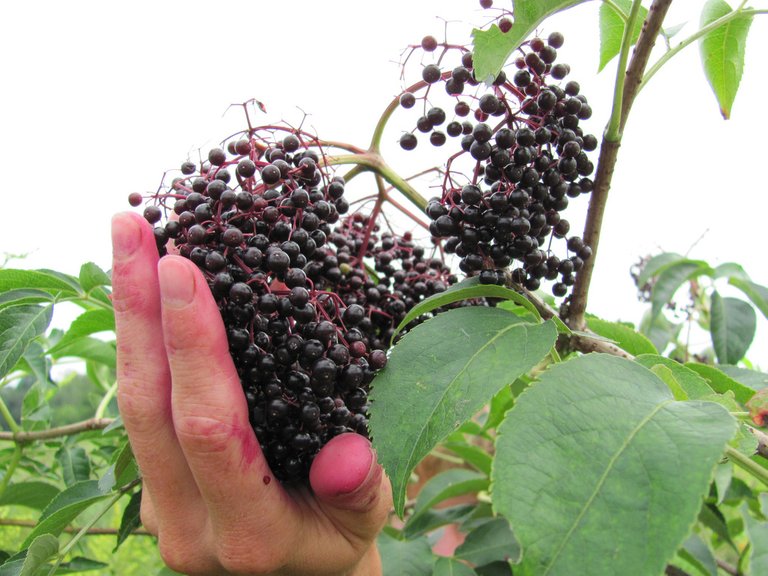
Just to be clear, we're talking about sambucus canadensis, the most common elderberry in North America. There is also sambucus negra, sambucus neomexicana and others. It gets confusing due to taxonomists' ever changing classification systems. The number sambucus of species varies form 5 to 30 so we'll stick with canadensis.
Clonal Propagation
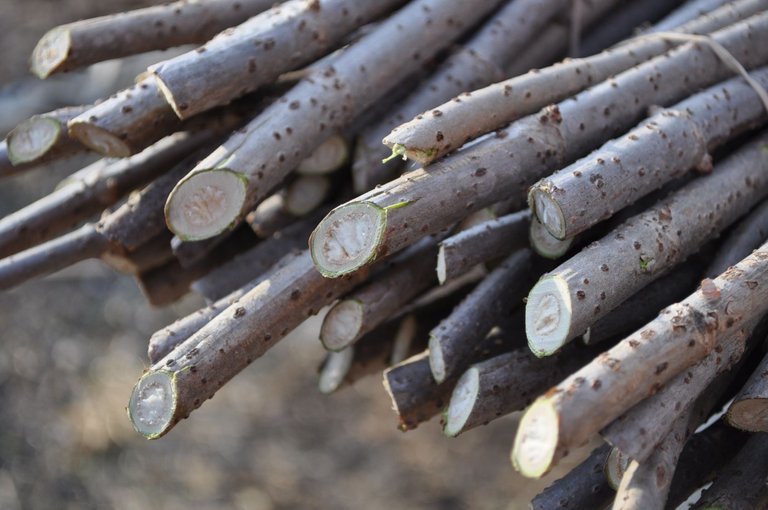
This fancy term makes the process sound like it happens in a lab, but it could not be simpler. Cloning is duplicating the genetic material from a parent, in this case a named and selected elderberry specimen that has particularly good characteristics.
We have chosen Bob Gordon, a 1999 selection of a wild elderberry that occurred naturally near Osceola Missouri (under 100 miles away from us). This variety is obviously well suited to our region and is unique in that it produces huge yields of 1/4" berries on first year wood! Yup that means it can be cut the ground (coppiced) every year which will keep the plant between 5 and 8 feet tall for easier harvest and management. Other varieties produce on 1st, second and even third year wood, and often in much lower quantities that this selection.
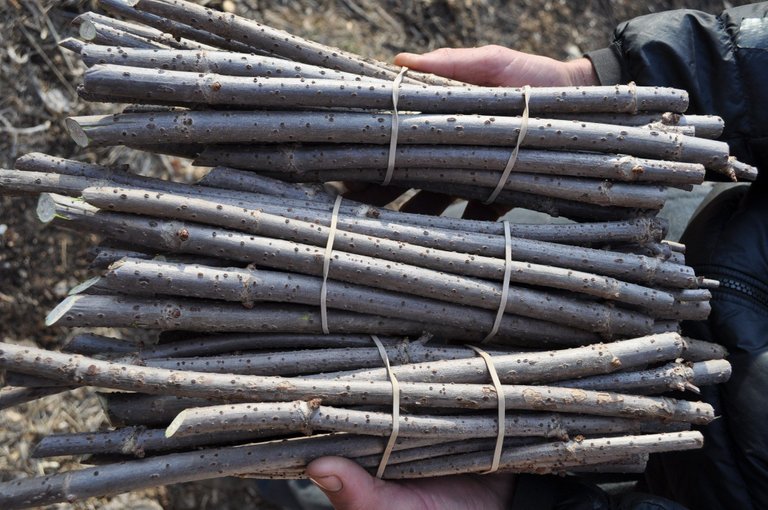
What we have is hardwood cuttings, taken during dormancy as part of routine coppicing. Each cutting contains 2 nodes. The nodes are where roots and leaves will emerge from. These cuttings contain the identical genetics to the plant that it was grown from and so on back to the selection near Osceola. We are simply regenerating and multiplying an individual plant that is unique and valuable.
Hardwood cuttings
This is the easiest way to obtain elderberry genetics as a plant can be cut during the winter dormancy and is easily handled and shipped. It required no diggin as with root cuttings or careful and lengthy germination as with seed propagation. We purchased ours from a local nursery that specializes in improved varieties of native edibles.
Once you have tracked down a source for cuttings and planted your own, you can multiply your plants and share with friends and neighbors! I'm envisioning a plant geek genetics exchange on Steemit where we can share the biodiversity of medicinal, productive and easy to grow plants.
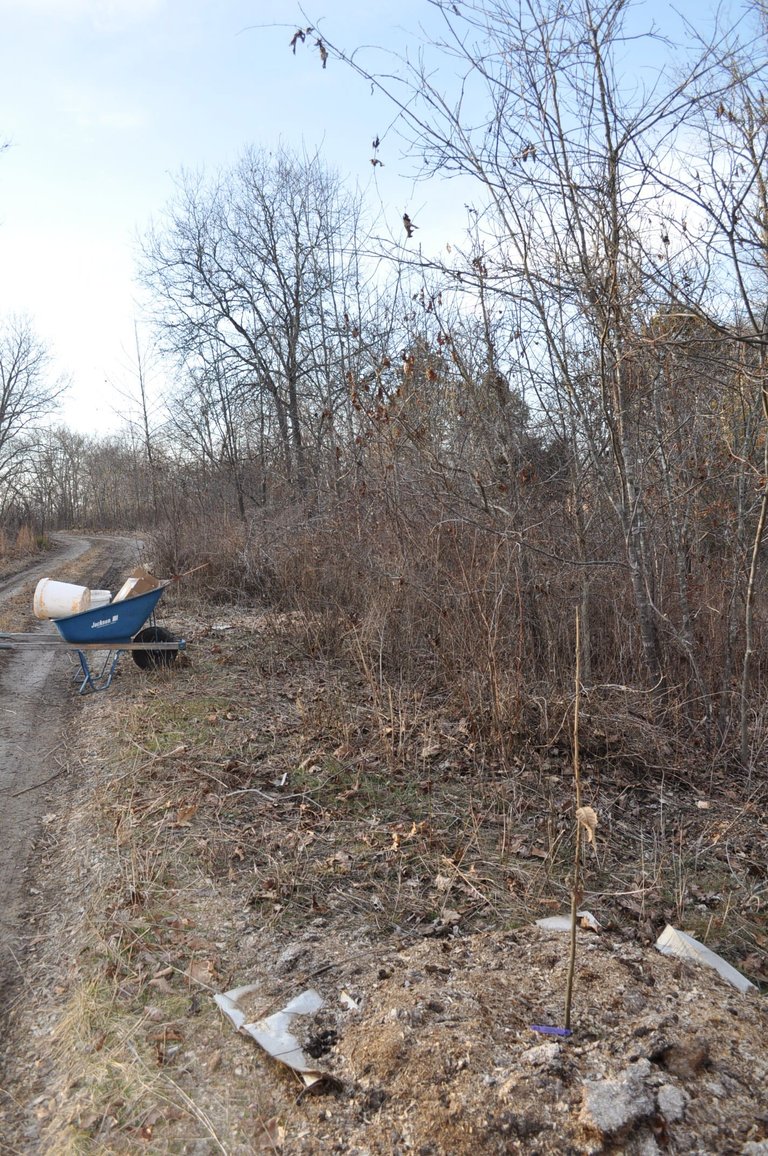
(Where we're planting some of the elder cuttings we got. The mulched plant you see here is a Chinese Chestnut and they run every 25 ft up our driveway.)
Getting it in the ground
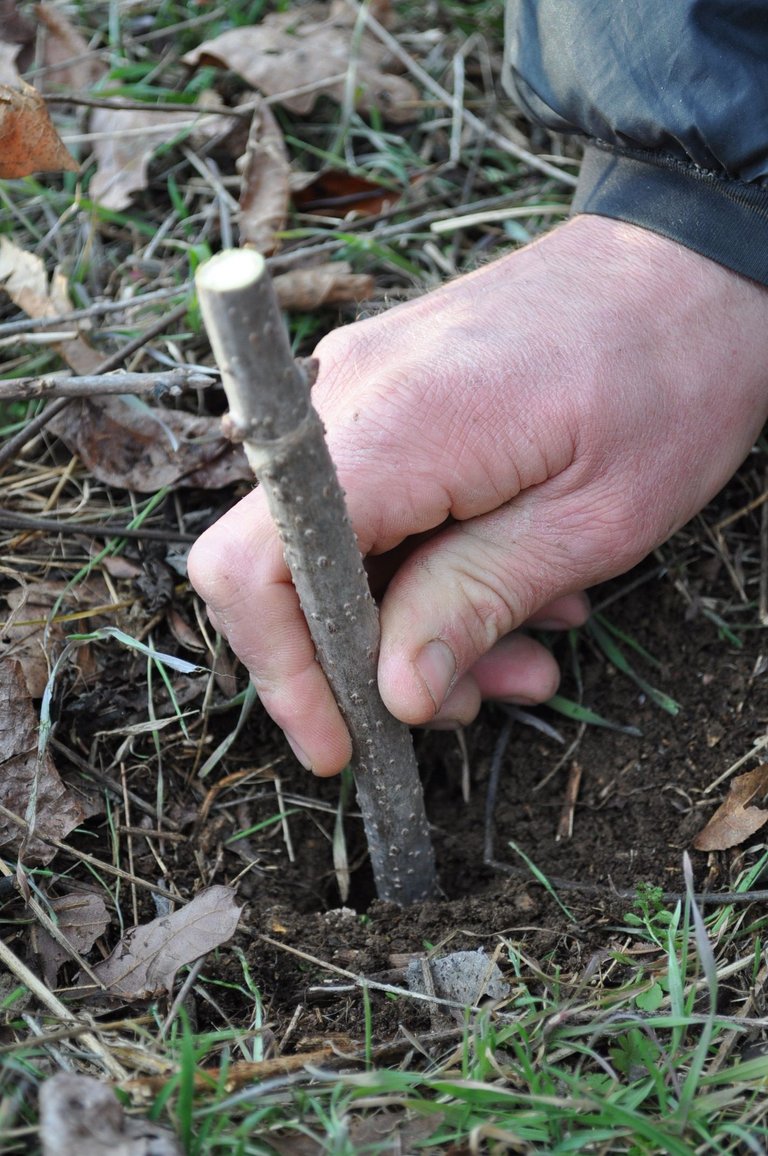
Here's my favorite part of this method. I love that you simply stick a cutting into the earth and allow the natural process of breaking dormancy and rooting to occur without human intervention. Some sources suggest rooting the cuttings in water indoors, then potting them and finally planting them. The man I bought them from says he has the same success rate either way.
If you can let nature take care of it why wouldn't you?
This is our approach @mountainjewel: whenever possibe allying with natural cycles and rhythms to allow for abundance and vitality to prosper! We are not interested in babying plants that don't need our attention so with elders we opt for the field planting method. No tender roots to fret over, no pots to water, no extra steps. Field data reports nearly equal success with potted cuttings and field planting, and rooting hormones simply aren't needed.
Last year I took some softwood cuttings from wild stock and rooted them in a few inches of vermiculite and sand. We left for over 2 months during a very hot and dry spell and some elders survived utter neglect verging on abuse. While I wouldn't advocate for this, these plants really want to grow and they're easy to grow!
Preparing the hole and planting

Most of our cuttings are about 1/4" in diameter so we used a 1/4" piece of rebar as a digging tool. With all the rocks we have, I'm happy when my digging requirements are low (another benefit of planting at this stage.)
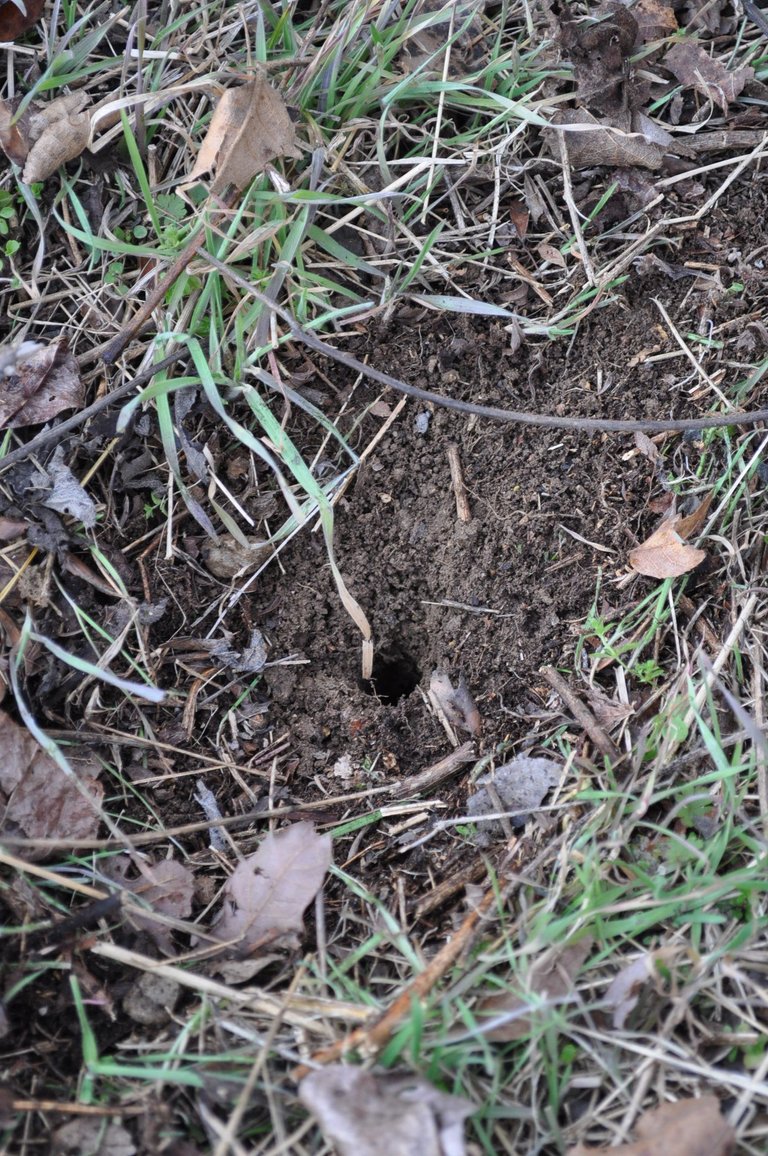
We poke the hole deep enough to set about half the cutting in the earth.
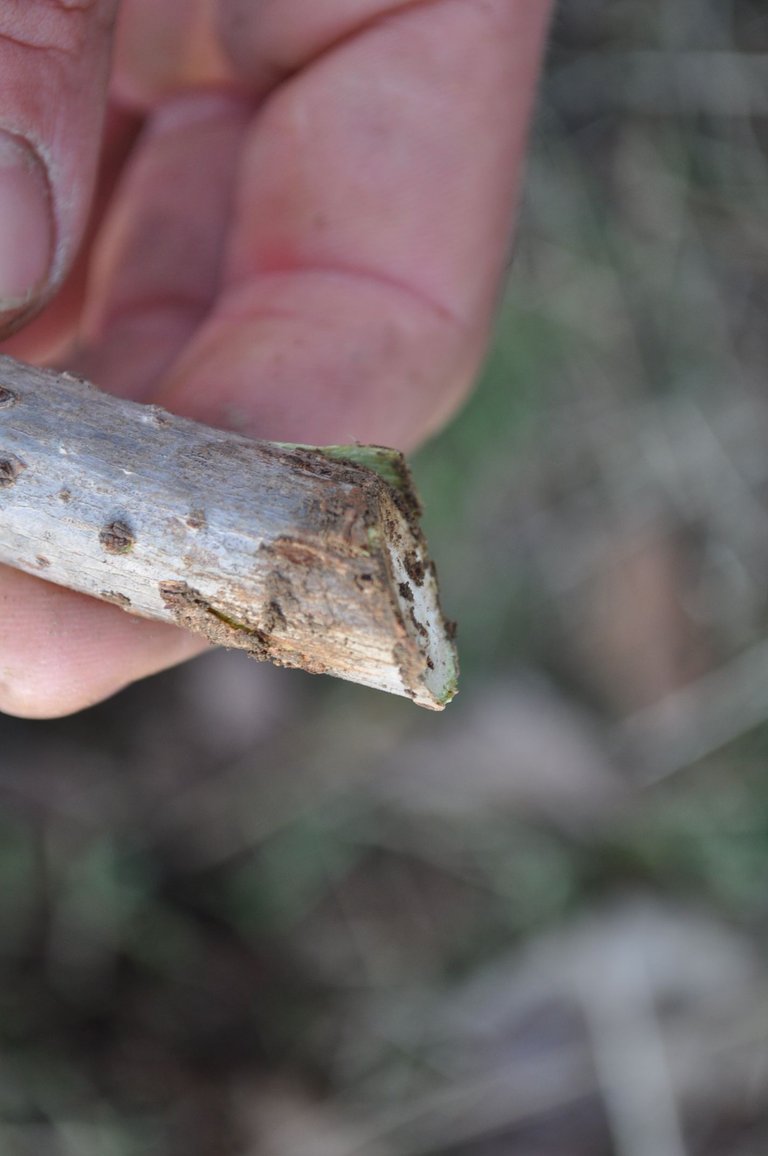
Making sure to place the 45 degree cut down, we insert the cutting and gently compress the surrounding soil, being careful not to damage the lower node.
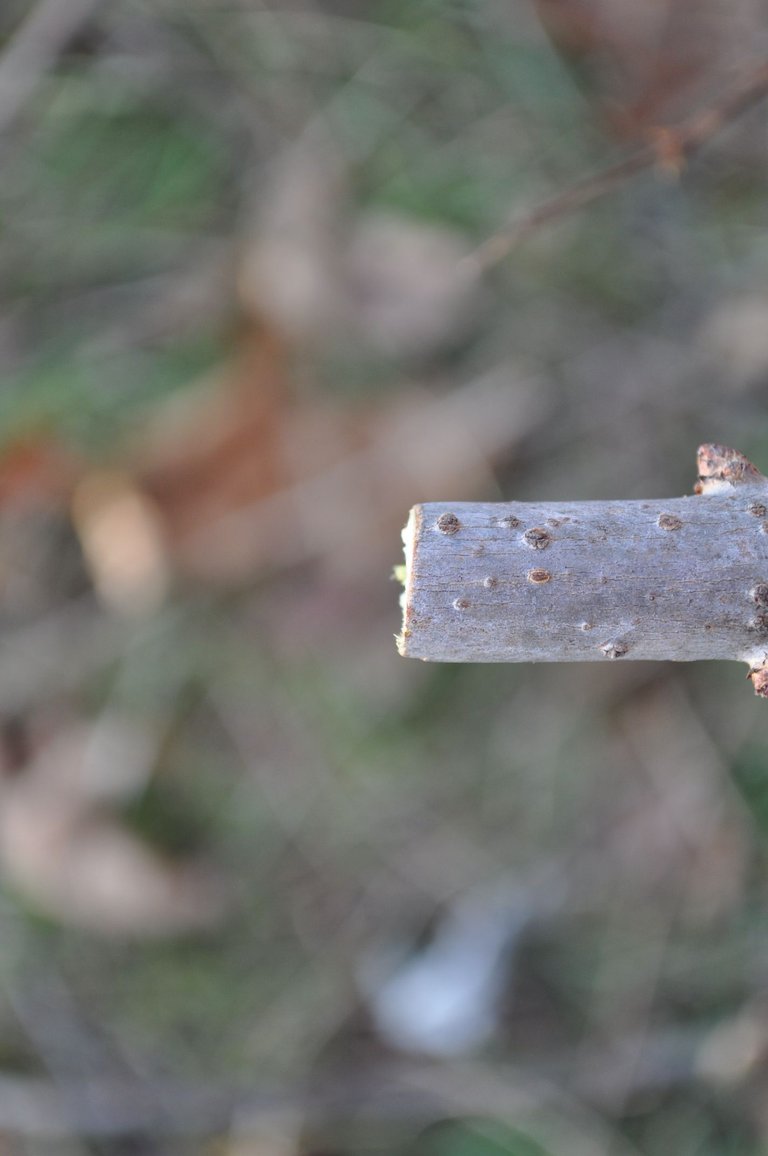
(Flat end goes up towards the sky)
Because the hole is small and the cutting is dormant, we're not worried about watering it as we normally would when planting. Our soil is moist at this time of year, but if we don't get a good soaking rain before spring, we will have to come back and drench the cuttings to ensure adequate moisture for new root development.
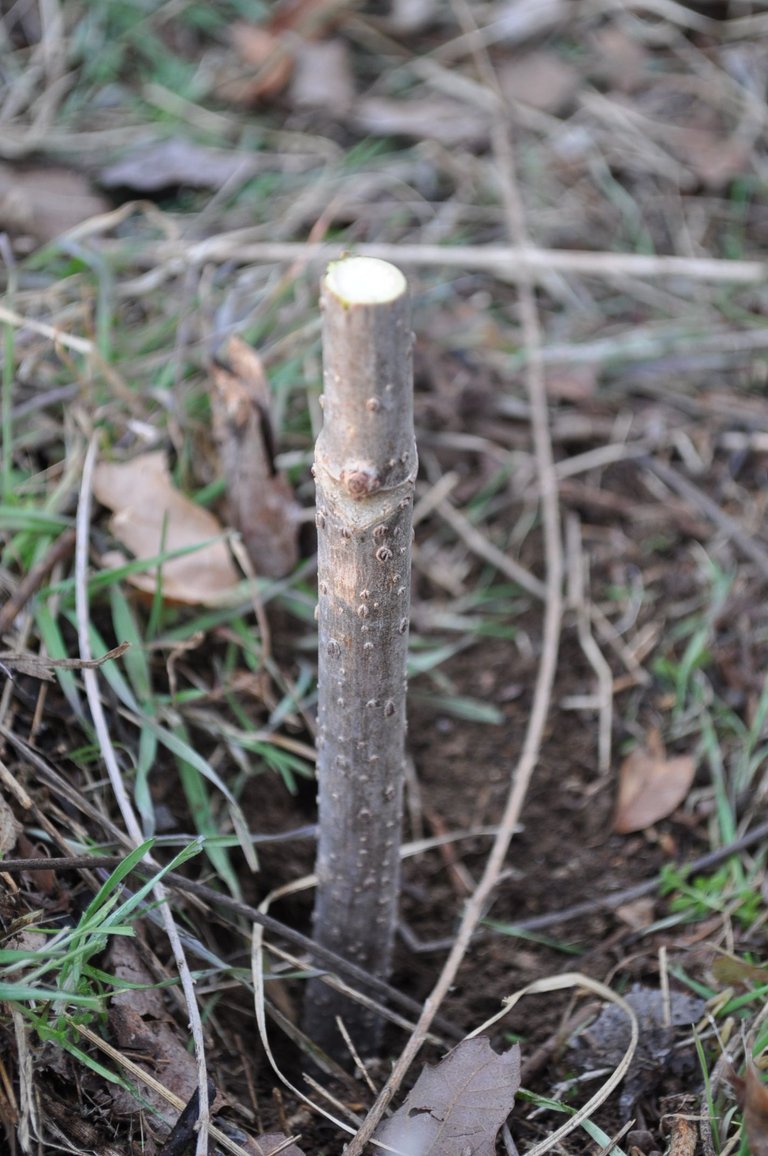
Caring for future roots
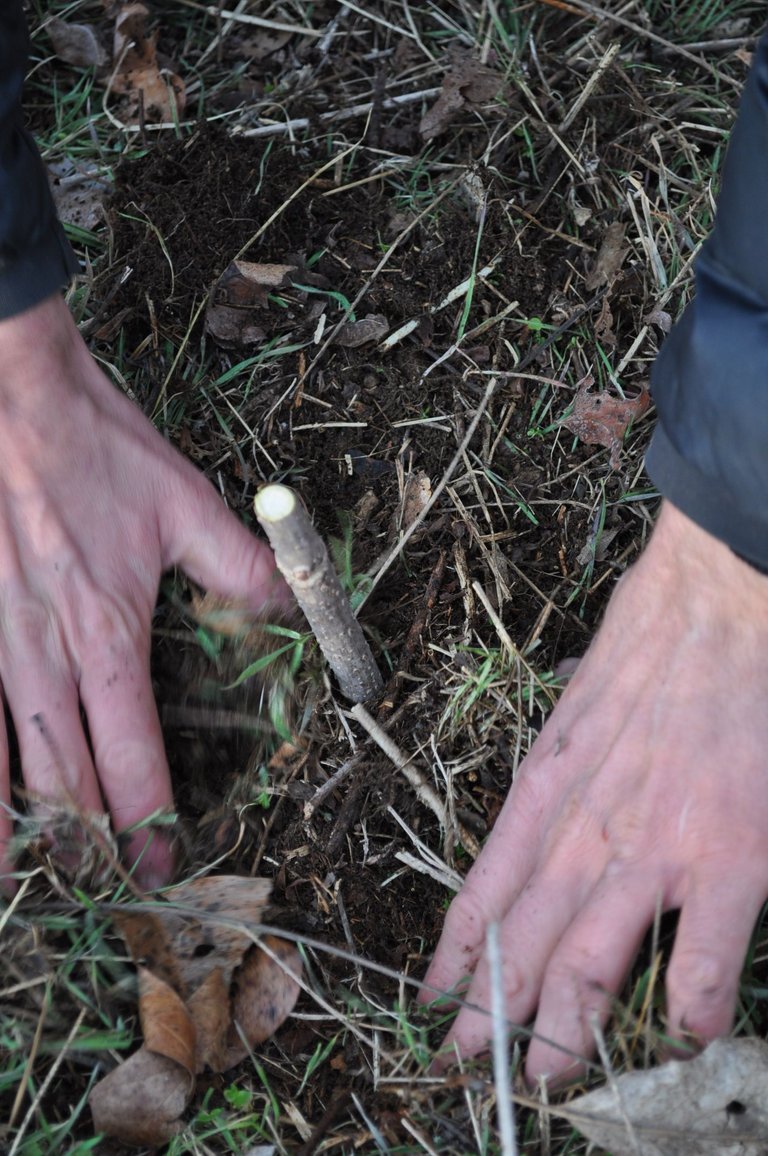
Here's where we're thinking looking ahead and taking care of future needs.
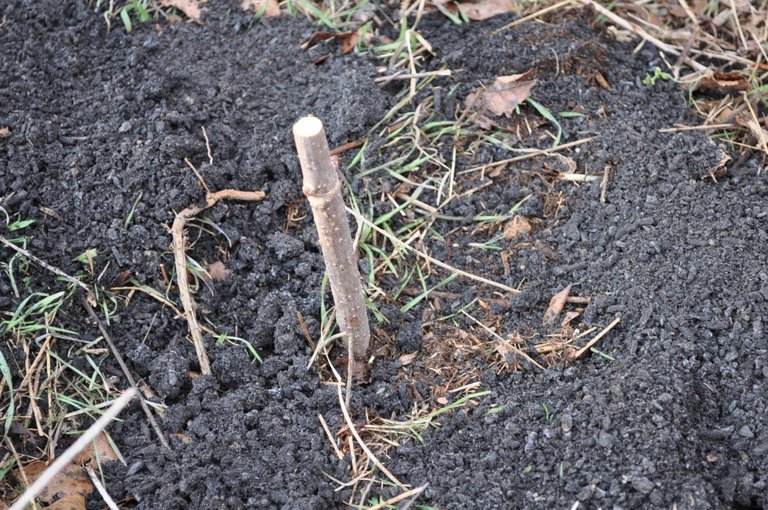
We amend the soil around the cutting with urine soaked biochar (check out part 1 and part 2) for more details on the beauty of biochar) to support adequate fertility and microbial activity.
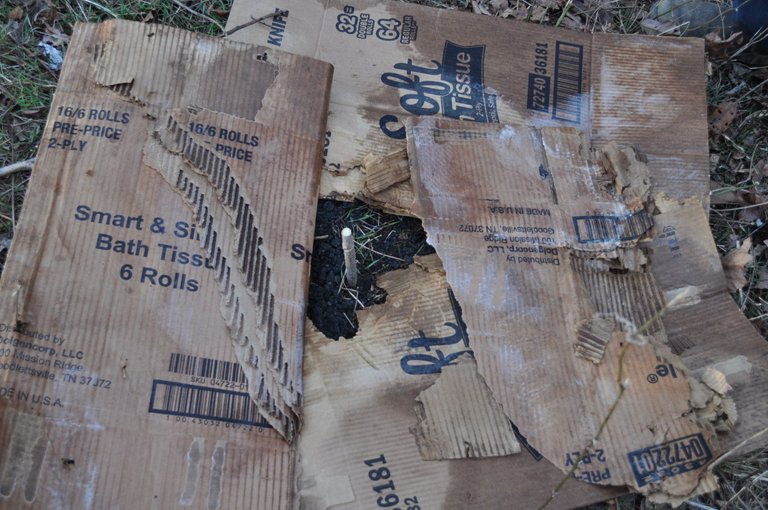
We cover the biochar with cardboard to suppress grasses from crowding the young plant and finally top dress with planer shavings to retain moisture and feed fungi (perhaps wood chips would be a more ideal mulch, but we take what we can get, eh).
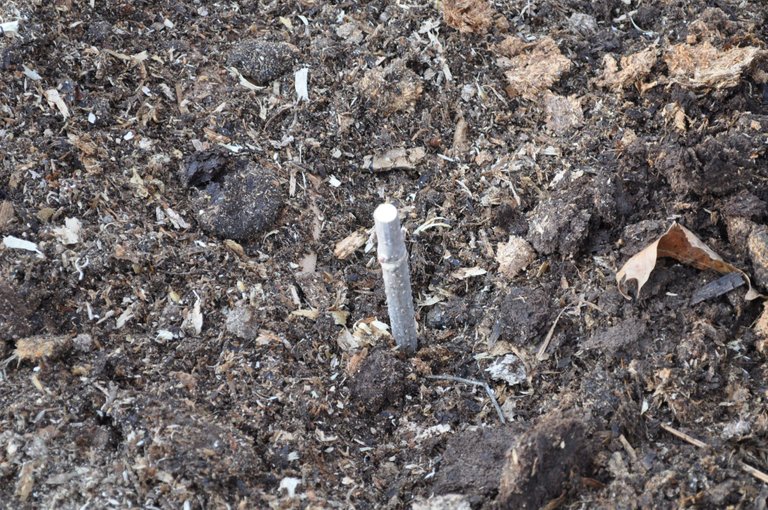
We may choose to inject mycorrhizal fungi into the root zone once the plants have established roots, although this may not be necessary as the soil has not been disturbed or damaged prior to us gently clearing it.
Plant and repeat
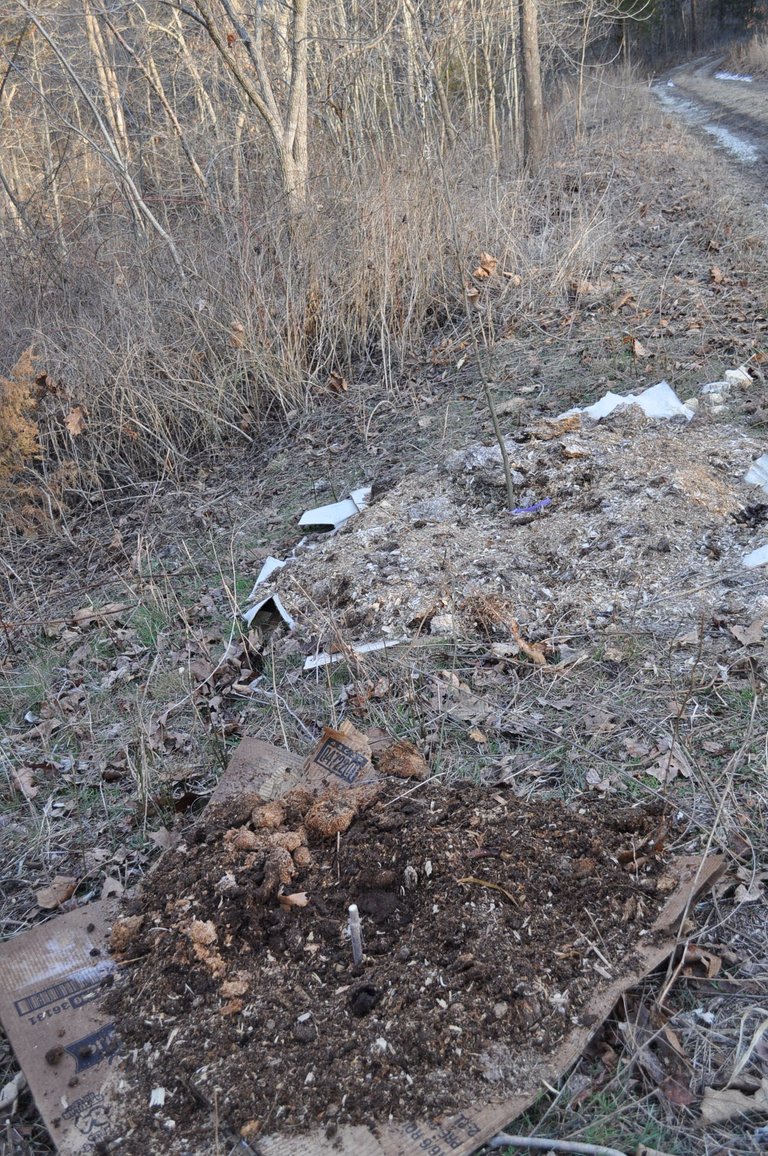
(First one of many planted along our driveway inbetween Chinese Chestnuts we planted last fall)
Now we just have to do this 75 more times to establish our first elderberry planting! This is a part of a grant that we got (we'll write about that soon!)
We will be planting the cuttings 4 feet apart and coppicing them each year. Think of how many more we can plant next year! Now we wait, take note of moisture, water if needed and allow the wisdom of elderberry to unfold.
(Main area where we're doing our fruit, nut, and medicinal tree and shrub plantings.)
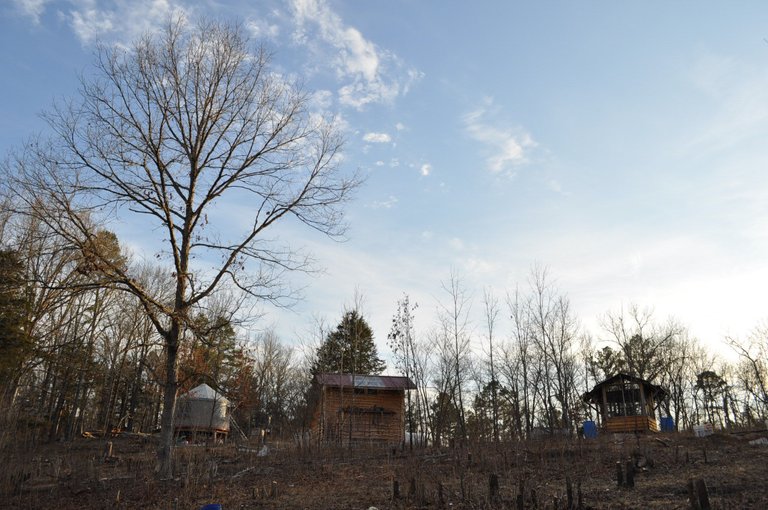

With 75 potential plants you are going to have an abundant harvest. We have about 20 plants and post on facebook to have friends come and pick them. 2 plants near our garden produced over 30 lbs, giving us enough for wine. We dehydrated others and juices the rest for jelly and made some brandy... All good stuff and make some interesting gifts for friends. Great post!
yesssss! love to hear this!!! good to get some context! yes to all the products you listed that you make. Way to go! Great gifts and I want to make a lot of elderberry syrup. Our hives are still young, but how cool to make a completely local product once we get some berries on and honey coming in.
Wow, 2 plants - 30 lbs! Love the abundance! More to share :D
Thanks for the info. I have about 20 Elderberry trees that I'm going to get in the ground yet this winter in preparation for the spring thaw. When I prune them I'm going to be doing the exact same process and propagating my cuttings. My wife makes our own Elderberry tinctures for Health and Wellness.
Yes! Love to hear it! Really it's such an incredible and easy to propagate and use plant it would be a boon to every homestead. Happy to hear of your endeavors :D
The cool thing about elderberries (from a growing perspective) is exactly that they are true "survivors." You can pretty much stick cuttings in the ground anywhere, water a bit and they GROW! I am reminded of many years ago seeing a garden where someone thought the nice straight branches of Elder would make good stakes... well, the stakes started growing!
haha ! great story of the resiliency and vigor of elders :D
I had heard of elderberry, but didn't realize you could use them for so many things. That's nice they're so easy to plant and get started. I hope you get an abundant crop!
thank you @themanwithnoname for your well-wishes!! They're truly incredible, easy to grow plants :)
Wow! Thats great info! I just recently learned how good elderberry is for you after having a bought of sickness that just wouldnt leave. Elderberry a few times a day for a few days and it was gone! I had no idea you could even grow elderberries like that, much less that its that simple! One day I shall try this :)
Yay! So grateful it's helpful for you :D and sounds like perfect timing after you've discovered how awesome it is. <3
Definitely! Thanks :)
Hah, makes me think of Monty Python and the Holy Grail: Your father smells of elderberries! Actually, my mom makes elderberry tinctures, I'm always taking them when I get sick.
I feel like I should make a group curation account for people with mountain named or themed accounts...
haha! great line! and cool that your mom makes elderberry tinctures...
and, what! another mountain... i have seen a few of us around ;) i would love to be a part of a similarly themed group/curation :) lol thanks for stopping by
Thanks for the informative, detailed post. My first resteem!
aww thank you! glad you found it so valuable <3
Make sure you keep those cuttings moist in the first few months! We tried exactly the same approach with Sambucus Nigra two years ago and while most of the cuttings leafed out, it turned out we put them in a place that drains quickly so when summer came, there was not enough moisture in the soil and they just dried and died!
And we could not water them, as we're currently propagating stuff in "the wild" meaning in the fields around our new garden, so no easy way to water anything. The good thing is the cuttings came from our own elderberry bush, so they cost nothing and we can just repeat the experiment until successful! :)
ps: Huh, you still have the yurt?
nice!! thanks for the experience boby! ... haha yes we still have the yurt! we cleaned it up while they were here and now it's a library/guest space :D
Very helpful post to most upvoted
thanks! glad you found it helpful
I've been taking elderberry syrup since my friend told me about and I have never been so impressed by my immune system! haha Unfortunately, all the sugar in the store bought stuff is a real annoyance! I may just have to find some cuttings (or a plant) of my own!
wow that's incredible news that you're feeling more immune than ever ;)
yes... it can be really annoying! i would definitely suggest just growing your own. as stipulated in the article, it is so easy. they also grow in the wild. i'm not sure where you live, but you can find them there as well. you could also probably find a really well made product somewhere on etsy searching for elderberry syrup. a ton of great herbalists on there. a little more pricey perhaps, but a good product :)
I had never thought to find homemade on etsy! great idea. I'm on Cape Cod and have seen plants with similar berries and got kind of excited but the stems are not woody and eating those i think might have the opposite result of what I'd like. haha
Glad I'm following you :D Last summer we had blackberries and planted wild strawberries, this summer i have plans for adding raspberries and blueberries, I'm going to have to give Elderberries a try :D
Yes! love to hear it!!! :D way to go on planting awesome fruits on the land. <3
Thank you for this. I love taking cuttings and this is amazing. I have an entire area that I'd love a big elderberry hedgerow, for jams and liqueur and wines. I will try this for sure!
Yay! glad to hear it.... and glad you love taking cuttings (how cool!).
Yessss!! us too! Look forward to seeing what you come up with :D a big elderberry hedgerow.. things are getting epic!!
Yes!!! Such a great post @mountianjewel we currently have a few Elderberry shrubs I planted here but they aren't named varieties...I am looking forward to planting a huge hedge this year, and especially for syrup and wine
syrup and wine are what i'm most excited for too! although someone above mentioned brandy and that sounds awesome, too!!!
Elderberries are one of my FAVORITE herbs!!!!
I did not know you could plant them as cuttings!! That is really cool. So can you do that with any variety? Or does it need to be a coppicing variety like the one you have?
We applied for a hedge planting grant from NRCS, and are hoping we get it!!!
yes any variety- from feral to cultivated!! sounds like your hedge grant could be fulfilled with plants you already have?!?! lol! always love it when it works out like that.
Thank you!!! Maybe! I especially wan tot plant the hedge to elderberries as one of the layers though!!!
Wow! Thanks for the info. We love elderberries and can't wait to plant some too. I was just listening to Alan Chadwick lectures and he mentioned that gophers don't like elderberries and so gardeners of old used to take elderberry cuttings in early spring and brush it on all their plants to deter pests as well as put the cuttings into gopher runs. Very curious to know if that actually works!
Wow thanks for that anecdote! Would be Cool if it works- let us know if you test it ;) we don’t have too many gophers...
Oh my gosh, no gophers?! That's amazing! Yes, we'll definitely be trying it soon enough because gophers abound in our neck of the woods. Luckily, wild elderberries also abound :). What kind of pests/weeds do you usually have and what's your strategy to deal with them?
haha no gophers, but we do have tunneling things-- maybe voles?? our cat sometimes gets em. we have seasonally shifting insect issues with aphids and squash bugs (destroyed nearly all the plants we had going last summer).. really our biggest "problem" is probably just sooo many rocks and poor soil! which we're slowly amending over time.
haven't figured out solutions for the top two. the aphids just go away when it dries out (seem to like moister shoulder seasons) and the squash bugs-- haven't figured that one out yet! if you have any solutions let us know :D
Thank you for contributing your knowledge to help others! This post has been added to the Sotall.org Directory of Self Sufficiency & Survival posts. One of our goals is to provide access to the knowledge of our fellow Steamians, that will still be seen, long after the 7 day period is passed. If you write any future articles with instructions on how to do any tasks related to a homestead or survival, to ensure they are added to the directory, please submit them. They will be added as soon as possible.
Oh how I love elderberrie flower syrup! Its very much consumed in Germany with a shot of that syrup in a glass full of sparkling mineral water. In Summer one of the most refrashing lemonades that exist! Also the syrip is very easy to make.
I am checking my cuttings as well at the moment to pop them into the ground in the first week of warmer temperatures.
Thank you for sharing!
That flower syrup in mineral water sounds Devine. On one of
Those days it gets over 100 F, i'm picturing us chillin in the creek with some of
ThAt. We'll have to get creative when the elders start yielding, plenty to explore. What kindness Are you growing?
What an amazing place you have! I love this article. Very informative. Here in Ireland we have the Negra...and there is also a shorter variety. Some people say these are toxic, but then I heard a woman from Romania say that in her country they say the short version is eatable and our Negra is toxic! LOL. So we pick them both...never any problems. I am fortunate enough to have an abundance of elder growing around the field here. In our old house, we picked the flowers and not long after we moved here, we were able to pick the berries. We had more than 8 kg. of berries! I make them into jam and syrup and we use it all year round. The kids love it (and I do too) and we always have enough to give to friends. It is truly one of the best things to have around the house!
Really nice article! I've bought seed for the Canadian and European varieties. I actually have lots of some kind of elderberry growing on my farm, but I forgot to mark their location so I'm going to have to wait until summer to find them again and get some cuttings, doh!
I have Adams and Johns varieties of elderberries, planted for good pollination. One is about 3 to 4 feet shorter and not as wide as the other and the smaller berry plants also produce smaller berries and have a shorter season. The larger of the two re-seed easily, almost becoming invasive and they flower early, get huge umbrells of berries and last well in to late fall. I have thought about taking cuttings, but the root systems of elderberry plants are shallow so where I had originally wanted to plant them - on a hillside - is not a good place. I do have a forest edge though and this would make a great understory planting at the edge of our prairie.
Good article.
Thanks for sharing some of your experience. Almost invasive you say? Well a plant with so many uses is welcome to take up some on our land happily. Forest edges seems like a great choice for a chosen planting spot.
Followed your link back to this article. Wondering how well the ground cuttings worked? Did you get a good success rate after doing this in the Spring? What height do you recommend for burying them? To the next node, halfway, or some other strategy?
With my bonsai tree cuttings, I usually get the best success rate when I put cuttings diagonally for some reason. Maybe that helps keep it better moisturized than upright. I always use a tray of sand with no drainage holes, and I get lots of lateral spreading roots, which is ideal.